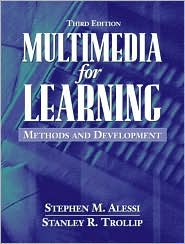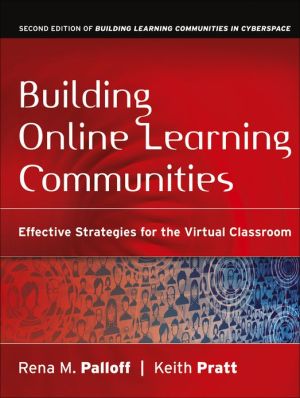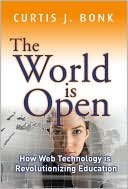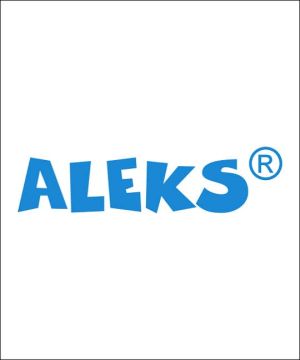Multimedia for Learning: Methods and Development
Features\ \ Research-based and applied text written by highly regarded authorities in the field.\ \ New To This Edition\ \ Extensively updated to cover the most current applications and edited to eliminate old topics.\ Coverage of modern multimedia (video and audio) and methods such as hypermedia and Web-based learning addresses the practical needs of teachers today (Chs. 5 and 11).\ Discussion of open-ended learning environments presents a recent topic teachers will be interested to examine...
Search in google:
This book shows how to use computers in educational settings by combining learning theory and instructional strategies to help the reader design software for learning and instruction. The book has been extensively revised to include new approaches to multimedia instruction as well as updating established methods such as tutorials, drills, simulations, games, and computer-based tests. Constructivist and instructivist approaches are analyzed and presented. The book is not equipment or software specific. Booknews Updating the 1991 edition of this volume, the authors cover general theories of learning applicable to all software for learning; a review of basic software characteristics; analysis of traditional and new methodologies for multimedia-based learning including tutorials, hypermedia, drills, simulations, games, tools, and open-ended learning environments, tests, and Web-based learning, with analysis in each case of the methodology's effectiveness. The last part describes a model for design and development, with practical suggestions for completing a project. Annotation c. Book News, Inc., Portland, OR (booknews.com)
Most chapters begin with "Introduction" and conclude with "Conclusion," "References and Bibliography," and "Summary." Preface. I. GENERAL PRINCIPLES. Introduction. A Short History of Educational Computing. When to Use the Computer to Facilitate Learning. The Process of Instruction. Methodologies for Facilitating Learning. Two Foundations of Interactive Multimedia. Developing Interactive Multimedia. Learning Principles and Approaches. Behavioral Psychology Principles. Cognitive Psychology Principles. Constructivist Psychology Principles. The Constructivist - Objectivist Debate. General Features of Software for Learning. Learner Control of a Program. Presentation of Information. Providing Help. Ending a Program. II. METHODOLOGIES. Tutorials. Questions and Responses. Judgement of Responses. Feedback about Responses. Remediation. Organization and Sequence of Program Segments. Learner Control in Tutorials. Hypermedia. Structure of Hypermedia. Hypermedia Formats. The Hypermedia Database. Navigation and Orientation. Support for Learning and Learning Strategies. Drills. Basic Drill Procedure. The Introduction of a Drill. Item Characteristics. Item Selection and Queuing Procedures. Feedback. Item Grouping Procedures. Motivating the Learner. Data Storage and Program Termination. Advantages of Multimedia Drills. Simulations. Types of Simulations. Advantages of Simulations. Factors in Simulations. Simulation Design and Development. Educational Games. Examples of Educational Games. General Factors in Games. Factors in the Introduction of a Game. Factors in the Body of the Game. Factors in the Conclusion of a Game. Pitfalls Associated with Creating and Using Games. Tools and Open-Ended Learning Environments. Construction Sets. Electronic Performance Support Systems. Microworlds. Learning Tools. Expert System Shells. Modeling and Simulation Tools. Multimedia Construction Tools. Open-Ended Learning Environments. Tests. Computerized Test Construction. Computerized Test Administration. Factors in Tests. Other Testing Approaches in the Computer Environment. Security. Web-Based Learning. What Is the "Web" in Web-Based Learning? Uses of the Web for Learning. Factors in Web-Based Learning. Concerns with Web-Based Learning. Advantages of Web-Based Learning. The Future of Web-Based Learning. III. DESIGN & DEVELOPMENT. Overview of a Model for Design and Development. Standards. Ongoing Evaluation. Project Management. Phase 1. Planning. Phase 2. Design. Phase 3. Development. Establishing Expectations. The Evaluation Form. Planning. Define the Scope of the Content. Identity Characteristics of Learners and Other Users. Establish Constraints. Cost the Project. Produce a Planning Document. Produce a Style Manual. Determine and Collect Resources. Conduct Initial Brainstorming. Define the Look and Feel of the Project. Obtain Client Sign-Off. Design. The Purpose of Design. The Audiences for Design Documents. Develop Initial Content Ideas. Task and Concept Analyses. Preliminary Program Description. Detailing and Communicating the Design. Prototypes. Flowcharts. Storyboards. Scripts. The Importance of Ongoing Evaluation. Client Sign Off. Development. Project Management. Prepare the Text Components. Write the Program Code. Create the Graphics. Produce Video. Record the Audio. Assemble the Pieces. Prepare Support Materials. Alpha Testing. Making Revisions. Beta Testing. Final Revisions. Obtaining Client Sign-Off. Validating the Program.
\ BooknewsUpdating the 1991 edition of this volume, the authors cover general theories of learning applicable to all software for learning; a review of basic software characteristics; analysis of traditional and new methodologies for multimedia-based learning including tutorials, hypermedia, drills, simulations, games, tools, and open-ended learning environments, tests, and Web-based learning, with analysis in each case of the methodology's effectiveness. The last part describes a model for design and development, with practical suggestions for completing a project. Annotation c. Book News, Inc., Portland, OR (booknews.com)\ \








